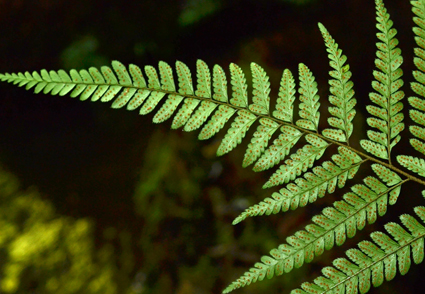Abstract
We here describe two new species Arachniodes libingii and A. vietnamensis (Dryopteridaceae) from southern China and central Vietnam, respectively. Our previous phylogenetic analysis found a close relationship between the two new species. Further morphological studies showed that the two species share short creeping rhizomes, blackish brown and lanceolate scales, papery laminae, aristate pinnules, dense scales along fronds, and entire indusia. However, A. libingii has deltoid-oblong laminae and apices abruptly acuminate-caudate, while A. vietnamensis has shortly ovate laminae and apices gradually acuminate.
References
Ching, R.-C. (1933) The studies of Chinese ferns IX. Bulletin of the Fan Memorial Institute of Biology 4: 103–107.
Ching, R.-C. (1962) On the nomenclature of the compound-leaved polysticha. Acta Botanica Sinica 10: 253–263.
Ching, R.-C. (1964) Notes on some confused species of Arachniodes Bl. Acta Phytotaxonomica Sinica 9: 367–385.
Ching, R.-C. (1965) Some new nomenclatural combinations of ferns. Acta Phytotaxonomica Sinica 10: 301–304.
Ching, R.-C. (1986) Filices novae sinenses generis Arachniodes Bl. Bulletin of Botanical Research 6: 1–78.
Christensen, C.F.A. (1905) Index Filicum. Hagerup, Copenhagen, 744 pp.
Copeland, E.B. (1947) Genera Filicum - The Genera of Ferns. Chronica Botanica Co., Waltham, 247 pp.
He, H. (2004) A taxonomic study of the fern genus Arachniodes Blume (Dryopteridaceae) from China. American Fern Journal 94: 163–182. https://doi.org/10.1640/0002-8444(2004)094[0163:ATSOTF]2.0.CO;2
He, H., Wu, S.-G., Xiang, J.-Y. & Barrington, D.S. (2013) Arachniodes Blume. In: Wu, Z.-Y., Raven, P.H. & Hong, D.-Y., (Eds.) Flora of China, Vols. 2–3. pp. 542–558.
Holttum, R.E. (1947) A revised classification of Leptosporangiate ferns. Journal of the Linnean Society of London, Botany 53: 123–158. https://doi.org/10.1111/j.1095-8339.1947.tb02554.x
Holttum, R.E. (1954) A Revised Flora of Malaya. Government Printing Office, Singapore, 653 pp.
Itô, H. (1925) Nuntia de Filicibus Japoniae (V). Journal of Japanese Botany 11: 573–583.
Itô, H. (1938) Polypodiaceae, Dryopteridoideae I. In: Nova Flora Japonica 4. Tokyo, Sanseido Co., pp. 118–121.
Lu, N.T., Zhang, L., Zhou, X.-M., Gao, X.-F. & Zhang, L.-B. (2018) Three new species of the fern genus Arachniodes (Dryopteridaceae) from Vietnam. Phytotaxa 376: 126–132. https://doi.org/10.11646/phytotaxa.376.3.1
Lu, N.T., Ebihara, A., He, H., Zhang, L., Zhou, X.-M., Knapp, R., Kamau, P., Lorence, D., Gao, X.-F. & Zhang, L.-B. (2019a) A plastid phylogeny of the fern genus Arachniodes (Dryopteridaceae). Molecular Phylogenetics and Evolution 133: 214–235. https://doi.org/10.1016/j.ympev.2018.12.013
Lu, N.T., Gao, X.-F. & Zhang, L.-B. (2019b) Arachniodes hehaii (Dryopteridaceae), a new fern from Guizhou, China. Phytotaxa 392: 84–86. https://doi.org/10.11646/phytotaxa.392.1.9
Morton, C.V. (1960) Observations on cultivated ferns VI–the ferns currently known as Rumohra. American Fern Journal 50: 145–155. https://doi.org/10.2307/1545259
Nguyen, P.L. (2020) Study of the genus Arachniodes Blume (Dryopteridaceae) in Vietnam. (Unpublished master’s thesis). VNU University of Science, Hanoi, Vietnam.
Pham, H.H. (1999) An illustrated flora of Vietnam, vol. 1. Nha Xuat Ban Tre, Hanoi, 618 pp.
Phan, K.L. (2001) Psilotophyta, Equisetophyta and Polypodiophyta. In: Nguyen, T.B. (Ed.) Checklist of plant species of Vietnam, Vol. 1. Agriculture Publishing House, Hanoi, pp. 951–955.
Phan, K.L. (2010) The updated Checklist of the Fern Flora of Vietnam following the classification scheme of A. Smith et al. (2006). Journal of Fairylake Botanical Garden 9: 1–13.
PPG I. (2016) A community-derived classification for extant lycophytes and ferns. Journal of Systematics and Evolution 54: 563–603. https://doi.org/10.1111/jse.12229
Raddi, G. (1819) Synopsis filicum brasiliensium. Opuscoli Scientifici d’una Società di Professori della Pontifical Università di Bologna 3: 279–297.
Rosenstock, E. (1914) XXXV. Filices extremi orientis novae II. Repertorium Specierum Novarum Regni Vegetabilis 13 (355–358): 129–135. https://doi.org/10.1002/fedr.19140130902
Roth, A.W. (1800) Tentamen Florae Germanicae, vol. 3. Gleditsch, Leipzig, 578 pp.
Smith, J. (1875) Historia Filicum. Macmillan & Co., London, 429 pp. https://doi.org/10.5962/bhl.title.54787
Tindale, M.D. (1961) Studies in Australian pteridophytes, No. 3. Contributions from the New South Wales National Herbarium 3: 88–92.
Thiers, B. (2020) [continuously updated] Index herbariorum: a global directory of public herbaria and associated staff. New York Botanical Garden’s virtual herbarium.


